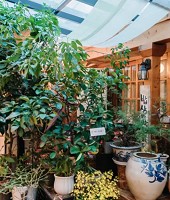Yoga Journal: “The Big Squeeze”
Capture the essence of summer fruits and vegetables, and give yourself a nutritional boost, with juice.
by Lavinia Spalding (google+)The newest addition to my kitchen takes up half the counter space. It's a hulking metal monster with razor-sharp teeth, able to masticate raw root vegetables like beets and turnips in seconds, turning them into a stream of vitamin-rich liquid and a pile of pulp squeezed so dry it's nearly fluffy.
I'd been feeling low-energy and thought that a concentrated source of vitamins might be just what I needed. When I went online to research juicer models, I stumbled onto an enthusiasm I didn't realize could exist for a gadget not made by Apple. The cult of the juicer promised endless vitality, smooth skin, shiny hair, free radicals beaten into submission. I had to have one.
When I was growing up in New Hampshire, most of the juice I drank came from a cardboard tube of slushy orange concentrate, and I loved it. In my 20s, I backpacked through tropical countries where street vendors peddled mango, litchi, and papaya juice in little plastic bags with straws. Fresh or frozen, juice has always been my beverage of choice. Lately, I'd fallen in love with store-bought fresh juices, but as a foodie obsessed with farmers' markets, I didn't always like being limited to the choices at the market. What if I wanted more cucumber than carrot, more beet than banana, more fresh than flash pasteurized? By making my own, I thought, I could have it all: organic, locally grown, seasonal, and uniquely tailored to my taste buds.
Juicing became popular in the early '90s, and it has enjoyed an enthusiastic resurgence inspired by the raw-food movement in recent years, with a proliferation of neighborhood juice bars, a wide variety of passionately reviewed juicer models, and more than a dozen books published in the past two years dedicated to fresh juice. Fresh juice is a staple for raw-food advocates like Terces Engelhart, co-owner of the San Francisco Bay Area's living-foods restaurants Café Gratitude. Besides juicing daily, Engelhart does a juice fast once a month in which she drinks, among other concoctions, a celery, kale, cucumber, and lemon juice blend. "There's something miraculous about drinking green juice," she says. "We're taking in chlorophyll and sunshine. It's so full of life force—it's liquid energy."
Liquid Life
Michelle Thatcher, a naturopathic physician in Tucson, Arizona, puts it another way: "Juicing is a great way to get a concentrated daily source of vitamins and minerals," she says. "And raw vegetables contain naturally occurring enzymes, which help your body break food down into more manageable, absorbable parts."
A recent study by researchers at the University of California at Davis found that drinking juice is likely to increase your overall vegetable consumption. Only about one-fourth of adults in the United States reportedly get their recommended five daily servings of vegetables, but all of the participants in the 12-week study, who drank 16 ounces of vegetable juice a day, managed to do so successfully.
Even so, juice shouldn't be thought of as a replacement for whole foods, warns Thatcher. "Juicing is a good supplement, but you're missing out on the valuable fiber you get when you consume raw vegetables," she says. "Insoluble fiber, such as that found in plants, is necessary in your digestive system to bind with cholesterol, toxins, and other fat-soluble substances so they can be excreted from the body."
Another important function of fiber, relative to juicing, is to slow down the body's absorption of sugar, as I was to learn the hard way. The day my juicer arrived, I hauled 30 pounds of produce home from the market, enough for a week's worth of fresh juice. My first creation, a simple orange-apple juice, was beautiful, frothy, and positively bursting with flavor. Over the course of the next few days, I made raspberry lemonade, sweet-potato-carrot juice, and a luscious cantaloupe-mint-mango blend. To my delight, every juice I made was delicious. But in my early days of juicing, I spent more than one afternoon wired, lightheaded, hungry, and exhausted, in approximately that order. "Juicing is great," says Thatcher, "but with fruit—or vegetables with a high carbohydrate content like carrots or beets—it's an inordinate amount of sugar to consume at one time, so you have to be judicious." When you drink apple juice, Thatcher says, you're concentrating the sugar of at least one and, more likely, several apples in one glass. If you ate a whole apple, the fiber and pectin would slow down the absorption of sugar into your bloodstream, but with the fiber removed, the sugar is absorbed more quickly, spiking your glucose levels. Thatcher advised me that, while one glass of fresh fruit juice a day wasn't necessarily detrimental to my health, I'd get more nutritional benefit from juicing vegetables, and she suggested I could mix a little fruit juice with my vegetable juice to make it more palatable.
After my experiences on the fructose roller coaster, I decided to take Thatcher's advice. I was a little hesitant. I loved commercial "green" juices, but I suspected that had more to do with the kiwi than the kale. And I had never been a particularly adventurous juice-bar patron; my one attempt at shooting ginger juice was about as pleasant as swigging grain alcohol, and after my first sorority sip of wheatgrass, I was looking for a plant to pour it into. So I started cautiously, feeding my juicer spinach, kale, and chard, adding smaller portions of whatever sweeter produce I had on hand. With each success, I was inspired to move on to ever more adventurous ingredients: asparagus, fennel, carrot tops. I learned which combos worked, like beet greens-lime juice-watermelon, and which didn't, like celery-broccoli-daikon, a foamy, khaki green concoction that tasted OK but smelled funny and made me burp for hours. Over the weeks, I grew accustomed to the pungent essence of green juice, happy in the knowledge that I was taking better care of myself.
Sugar Rush
Another important function of fiber, relative to juicing, is to slow down the body's absorption of sugar, as I was to learn the hard way. The day my juicer arrived, I hauled 30 pounds of produce home from the market, enough for a week's worth of fresh juice. My first creation, a simple orange-apple juice, was beautiful, frothy, and positively bursting with flavor. Over the course of the next few days, I made raspberry lemonade, sweet-potato-carrot juice, and a luscious cantaloupe-mint-mango blend. To my delight, every juice I made was delicious. But in my early days of juicing, I spent more than one afternoon wired, lightheaded, hungry, and exhausted, in approximately that order. "Juicing is great," says Thatcher, "but with fruit—or vegetables with a high carbohydrate content like carrots or beets—it's an inordinate amount of sugar to consume at one time, so you have to be judicious." When you drink apple juice, Thatcher says, you're concentrating the sugar of at least one and, more likely, several apples in one glass. If you ate a whole apple, the fiber and pectin would slow down the absorption of sugar into your bloodstream, but with the fiber removed, the sugar is absorbed more quickly, spiking your glucose levels. Thatcher advised me that, while one glass of fresh fruit juice a day wasn't necessarily detrimental to my health, I'd get more nutritional benefit from juicing vegetables, and she suggested I could mix a little fruit juice with my vegetable juice to make it more palatable.
Going Green
I found that juicing was a rewarding way to satisfy my urge for creativity in the kitchen, since the possibilities were practically limitless and almost always tasted great. And unlike some of my other forays into experimental cooking, I got to taste the results almost immediately. Sometimes I poured my fresh vegetable juice into a bowl, added a little sea salt and garlic, and ate the savory "cold soup" with a spoon. As I got to know my juicer better, I made fruit smoothies, frozen juice pops, sparkling berry drinks, and lemongrass-mint marinade. I froze the fiber-rich pulp to use in soups, desserts, and sauces. I turned from timid scientist to intrepid chef, adding a lime here, baby arugula leaves there. And even after the honeymoon period was over, I still found juicing fairly easy to do on a regular basis.
I bought my juicer looking for culinary thrills and a few extra vitamins, and I got them. But to my surprise, juicing also inspired some significant changes in my lifestyle. Once I started juicing, I recommitted to buying everything organic, since juicing concentrates any pesticide residue. I eat a lot more whole fruits and vegetables now, simply because I have them on hand. Ingredients I once overlooked catch my eye at the market, so my diet varies like never before. I've even reversed my aversion to certain foods—never a bell pepper fan, I'll happily drink tomato-bell pepper juice with lime. But the most obvious change might be in my morning routine. For nearly 20 years I started every day by guzzling a French-press pot of coffee. But when I juice first, I feel more energized, hydrated, and alert.
Totally Juiced
All told, thanks to juicing, I've slipped into something a little healthier. I don't think I'm ready to ditch my coffee press altogether, but I am willing to give wheatgrass another shot—perhaps mixed with grapefruit and mint this time. Picking up a rosy stone-fruit hybrid I'd never seen before at the market the other day, I thought, "Whatever this thing is, I'm juicing it." And I did.
-
The New York Times, Modern Love: How I Learned to Trust (Some) Men
-
The New York Times, Modern Love: “Goodbye, My Fantasy Man”
-
AFAR Magazine: “Playing by Heart” (Winner of a Gold Lowell Thomas Award)
-
Longreads: “The Cabin”
-
River Teeth: A lot of Tomorrows
-
Going: New Orleans, The Southern US City Where Jazz Was Born
Parents: I Grew Up in a Haunted House—Here’s What I Tell My Child About Ghosts
AFAR: Seoul Food
Off Assignment, Letter to a Stranger: “To the Shopkeeper in Fez”
The Bold Italic: “Working Three Jobs Nearly Killed Me”
AirBnB Magazine: “So I Slept in a ...Cave”
AAA Westways Magazine: “Korean Encore”
AFAR.com: “Everything You Need to Know About Jazz Fest”
AFAR.com: “Get Beyond the Beads: The 101 on Mardi Gras Throws”
AFAR.com: “The Art of Eating Crawfish in New Orleans”
AFAR.com: “Find New Orleans’s Soul at These 6 Mini-Museums”
Ms. Magazine: “Politics is on the Menu at Hell’s Backbone Grill”
AirBnB Magazine: “New Orleans for the Celebratory”
Off Assignment, Letter to a Stranger: “To the one who was supposed to get away”
Off Assignment, Letter to a Stranger: “To Old Johnny”
Viator: “Coming Full Circle”
World Hum: “How Korean Karaoke Changed my Life”
Independent Bookstore Day’s anthology: “My Lesson from Hell”
Sunset Magazine: “Carried Away”
-
The New York Times, Modern Love: “Goodbye, My Fantasy Man”
I wasn’t willing to settle for less than kismet. But chasing a romantic illusion nearly kept me from finding love. -- The night I agreed to try online dating, I told my roommate Meghan I hoped I wouldn’t meet anyone because that wasn’t the kind of story . . .
-
River Teeth: A lot of Tomorrows
We are at the dinner table when my young son asks, “The day after a lot of tomorrows, will we build a treehouse?” I want to scoop him in my arms, this boy so eager and fresh, so tall his forehead meets my shoulder. If I could, I would lift his body above . . .
-
AFAR: Seoul Food
I still clearly remember my first meal in South Korea. I had just arrived in the country, fresh out of college and ready to begin a job teaching English. My new boss had whisked me from the airport to a barbecue restaurant, where I’d watched in panic as . . .
-
The New R&R
. . .
 Yoga Journal
Yoga Journal




























